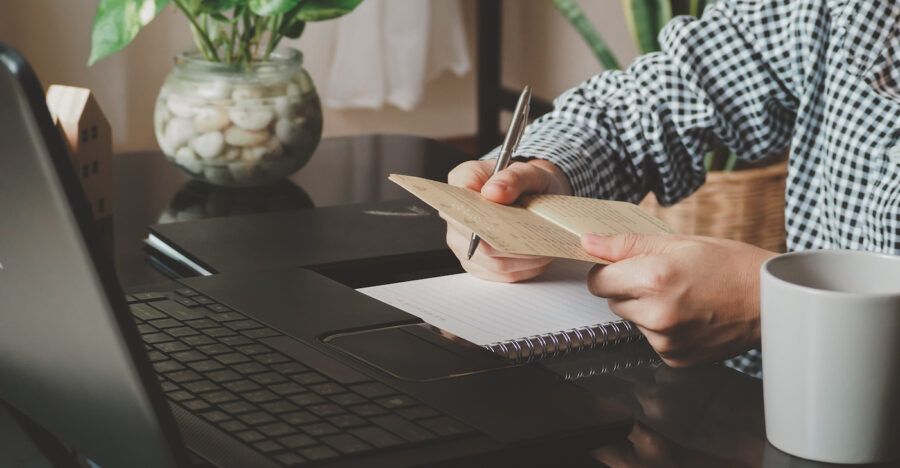In this article:
Balancing your checkbook might feel like an archaic practice since the use of paper checks is falling out of style, but it still serves a purpose. The practice is a way to get a solid handle on how much money is going in and out of your account each month, which can help you identify fraud and keep tabs on how much money you have. Let's go over what balancing your checkbook is and how to do it.
What Is Balancing Your Checkbook?
You needn't be making all your transactions with paper checks in order to have a checkbook to balance. In accounting terms, checkbook balancing is the act of reconciling your account by matching up the debits and credits on your bank statement to your own record of transactions.
You can balance your own checkbook by keeping a paper or digital log of bank account transactions that you can compare against your bank statement each month.
Why Balancing Your Checkbook Is Important
Balancing your checkbook is a way to verify that each bank deposit, debit card purchase, money transfer and withdrawal is accurate. Checkbook balancing can help you:
- Catch and report banking errors
- Track spending and gain a better understanding of your expenses
- Identify deposits that don't clear
- Spot fraud or unauthorized purchases or withdrawals
How to Balance Your Checkbook
Reconciling your bank account is a monthly financial "to-do" that could take under an hour. Here are the steps to get started:
1. Choose Your Recording Method
The traditional place to log your transactions in a checkbook is called a "check register." This provides a place to input all pertinent information related to every transaction, including purchases, deposits and things like refunds. If you don't have a check register, you could download a free check register template online or create one that works for you with an app or notebook. Below is an example of the column headings to include on a do-it-yourself check register if you create your own.
2. Log Your Beginning Balance
Once you've decided how to log transactions, put your starting bank account balance at the top right of your table. If you pull your balance from an online banking dashboard, use your "available balance" because this figure should include pending transactions.
3. Add Each Account Transaction
Each time you add or remove money in your account, include the transaction in your log and calculate your new balance. Transactions to list include all checks you write, checks you deposit, ATM withdrawals, bill payments, money transfers or any other type of transaction that causes a debit or credit to your account. Here's an example:
4. Compare Your Check Register to Your Bank Statement
At the end of the statement period, use your check register to match the balance and each transaction to your bank statement. If your balance and transactions match up, your work is done, and you can start logging transactions for the next month. If there's a mismatch, it may take some work to figure out what the cause is.
4 Reasons Your Checkbook Might Not Balance and What to Do
If your check register and bank statement don't balance, double-check your math to see if there are any adding or subtracting errors on your register.
Next, make a note of unusual transactions and missing deposits to investigate further. Below are some scenarios that may cause your bank balance to be off and what to do next.
1. A Check Hasn't Cleared
Banks may hold checks to verify funds or bounce a check entirely if the check writer's account has insufficient funds. If a check doesn't clear, you may need to contact the check writer for another payment or contact the bank to ask how long the check-clearing process will take.
2. You or Your Bank Makes a Mistake
Banking mistakes can happen. Maybe you type in $50 when processing a check deposit instead of $500, resulting in an end-of-month shortage of $450. Or a bank teller types in the wrong amount when you deposit a check in person. In this scenario, gather backup to prove your case for why it's an error and contact the bank for instructions on how to fix the issue.
3. A Merchant Makes a Mistake
A merchant could overcharge you or double charge you for an order or purchase, causing your check register and bank statement to be off. In this scenario, contact the merchant to dispute the charge and then report the transaction to the bank.
If you return an item, sometimes it can take several weeks for a retailer to issue a refund. In this situation, you may need to hold off on recording the refund credit to your check register until the merchant processes it and it shows up as a refund on your bank statement.
4. You're a Victim of Fraud
Your bank account balance at month's end may end up being lower than expected if someone is making unauthorized purchases. It's important to let your bank know about fraudulent charges right away because reporting it quickly can limit your liability for unauthorized charges.
Don't Write Checks? It's Still Good to Balance Your Checkbook
The term "balancing your checkbook" sounds like it might only mean tracking check payments, but it involves tracking every bank transaction and double-checking them against your monthly bank statement.
There are plenty of robust financial apps that can help you create a ledger of transactions if you don't want to do this task by hand—but you don't need anything fancy to get started. Good old-fashioned Microsoft Excel or paper and pen could be enough to help you keep track of where your hard-earned money is going so you can make sure it's being spent in the right place.

